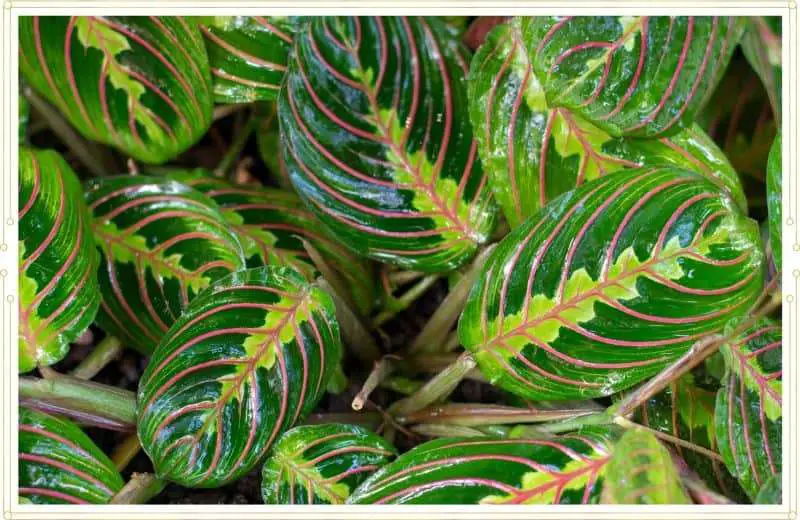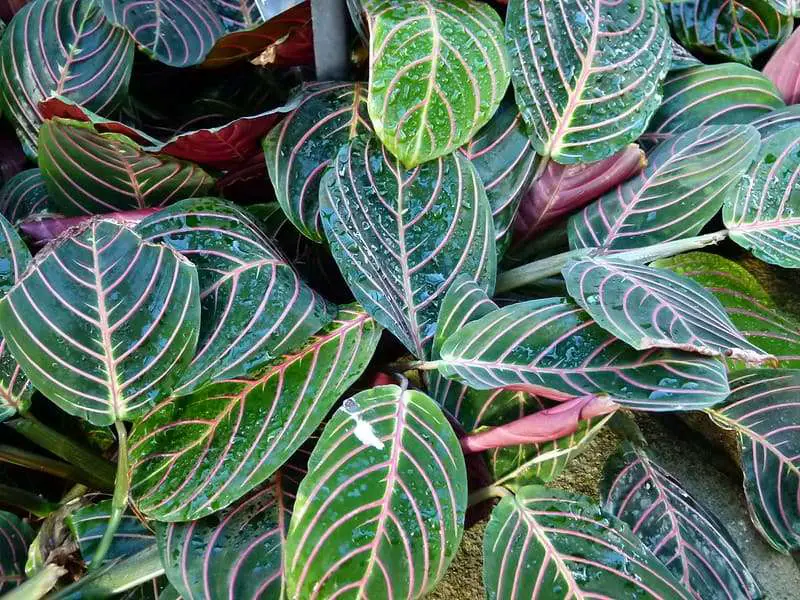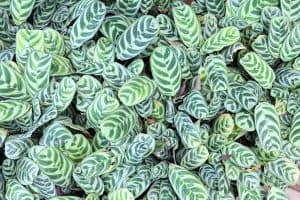This post contains affiliate links. If you buy something from one of our links we may earn a commission. Thanks

If you’re lucky enough to have a prayer plant in your home, then you know just how beautiful they are. They add a splash of color and life to any room they’re in.
Prayer Plant Key Takeaways:
- Prayer Plant Care entails providing bright, indirect light, maintaining moist but well-drained soil, and ensuring a humid environment.
- Regular watering, when the top inch of soil feels dry, and monthly fertilization during the growing season will keep your Prayer Plant healthy.
- Proper care, including occasional pruning, will help showcase its vibrant foliage and unique leaf-folding behavior.
Taking care of them can be tricky and not many people know how to do it properly. That’s why we’ve put together this Prayer Plant Care Instructions guide.
The prayer plant is in the species Calathea and is closely related to the rattlesnake plant which also folds its leaves at night.
In it, you’ll find everything you need to know about keeping your prayer plant healthy and looking great!
Prayer Plant An Overview
There are few houseplants as beautiful or easy to care for as the prayer plant. This striking foliage plant is native to tropical regions of Brazil.
The Prayer Plant gets its name from its habit of folding its leaves upward at night, as if in prayer.
While the Prayer Plant is most commonly grown as a houseplant, it can also be used outdoors in shady garden beds during the summer.
When given adequate moisture and humidity, the Prayer Plant will reward gardeners with bright green leaves that are striped with yellow or white.
The Prayer Plant is a member of the Marantaceae family, which also includes the popular Calathea and Stromanthe species.
Thanks to its easy care requirements and attractive foliage, the Prayer Plant is a great choice for both beginning and experienced gardeners alike.
Here are a few tips for keeping your Prayer Plant healthy and happy:
Soil: The Prayer Plant prefers loose, well-draining soil with plenty of organic matter.
If your tap water is high in chlorine or fluoride, it’s best to use filtered or distilled water for your plant.
Watering: Keep the soil moist but not soggy. Water your Prayer Plant when the top inch of soil feels dry to the touch.
In very warm weather, you may need to water twice a week. Be sure to empty any water that collects in the saucer beneath the pot,
Sitting in water can cause root rot.
Fertilizing: Feed your Prayer Plant monthly during the growing season (spring and summer) with a balanced liquid fertilizer diluted to half strength.
During the fall and winter months, fertilize every other month.
Pruning: Maranta leuconeura, or Prayer Plant, is a beautiful houseplant that is known for its colorful leaves.
While it is relatively easy to care for, it does require some occasional pruning to keep it looking its best.
The best time to prune your Prayer Plant is in the early spring before new growth begins.
First, cut off any dead or damaged leaves. Next, trim back any long or leggy stems.
Finally, shape the plant by trimming back any stray branches.
You can also pinch back growing tips to make the plant grow more leaves and branches and bush out.
Pruning your Prayer Plant will help to encourage new growth and keep your plant looking its best.
Prayer Plant Care Instructions

Here are more detailed instructions for caring for your prayer plant including potting and propagating prayer plants.
- Common Name: Maranta, Prayer plant
- Scientific Name: Maranta leuconeura
- Native Location: Central and South America especially in Brazillian tropical forests, West Indies
- Plant Type: Evergreen perennial
- Watering Needs: Average
- Mature Size: up to 12 inches tall while 6-inch tall leaves
- Sun or Shade needs: Bright, indirect sunlight
- Humidity: High
- Temperature: 60 to 80 degrees F
- Soil Type: Well-draining and rich
- Soil pH: Acidic
- Bloom Time: May to July
- Hardiness Zones: 11 to 12
How To Propagate Prayer Plant: 4 Methods To Do It Successfully (urbanorganicyield.com)
Prayer Plant Soil & Watering Needs
These tropical natives thrive in warm, humid conditions and prefer soil that is high in organic matter and well-draining.
When watering prayer plants, be sure to use lukewarm water and allow the soil to dry out somewhat between waterings.
Too much water can cause the roots to rot, so it’s important to err on the side of too little rather than too much.
Prayer Plant Light Requirements
One of the reasons it is such a popular plant is that it is relatively low maintenance when it comes to light requirements.
Prayer Plants do best in bright, indirect light but can also tolerate lower light levels.
If you are growing your Prayer Plant in a spot that doesn’t get very much natural light, you may need to supplement with artificial grow lights.
Prayer Plant Fertilizing Needs
The Prayer Plant (Maranta leuconeura) is native to the tropical rainforests of Brazil, and they thrive in warm, humid environments.
If you live in a dry climate, you may need to mist your Prayer Plant regularly to keep it healthy.
In terms of fertilizing, Prayer Plants don’t need a lot of nutrients. Once a month during the growing season is sufficient.
As any gardener knows, plants need nutrients to grow. However, different types of plants have different fertilizer needs.
When fertilizing a prayer plant, it is important to use a balanced fertilizer.
Water the plant well after fertilizing, and be sure to allow the soil to dry out between waterings.
Prayer Plant Potting & Repotting Needs
If you’re lucky enough to have a Prayer Plant of your own, you’ll need to repot it every one to two years.
Here’s what you need to know about Prayer Plant potting and repotting:
When repotting your Prayer Plant, be sure to use a pot that has drainage holes.
Choose a pot that is one size larger for transplanting. You will want to have fresh well-draining potting mix on hand for repotting.
Be careful not to damage the roots when you’re repotting, and water well after repotting.
Your Prayer Plant will likely need less water in the winter months, so be sure to adjust your watering accordingly.
Prayer Plant Propagation Methods
Prayer plants are a popular houseplant, known for their beautiful foliage and easy care.
These plants are relatively easy to propagate, and there are a few different methods that can be used.
One of the easiest ways to propagate prayer plants is by division. This can be done by carefully removing the plant from its pot and then dividing the rooted clumps into smaller pieces.
Once the plants have been divided, they can be replanted in fresh potting mix.
Another way to propagate prayer plants is by stem cuttings. To do this, take a sharp knife or pair of scissors and cut a 4-inch piece of stem from the tips of the plant.
The cutting should include at least one set of leaves. Remove the lower leaves from the cutting, and then pot the cutting in moistened potting mix.
Keep the cutting warm and humid, and in time, it will develop roots and start to grow.
With either method, it is important to use fresh potting mix and to water regularly until the plants are established.
Prayer Plant Pests & Diseases to Look Out For
As any gardener knows, pests and diseases can quickly ruin a healthy plant.
While there are many products on the market that claim to be effective against pests and diseases, the best defense is always prevention.
When it comes to prayer plants, there are a few common pests and diseases to look out for.
Aphids are small, soft-bodied insects that feed on plant sap. They can be controlled with regular applications of insecticidal soap.
Powdery mildew is a white or gray powdery fungus that affects the leaves of prayer plants.
It is most commonly seen in humid conditions. To prevent powdery mildew, water the plant at the base rather than from above, and make sure the leaves are dry before nightfall.
If you do see powdery mildew on your plant, treat it with a fungicide.
Spider mites are tiny spider-like creatures that feed on plant tissue. They can be controlled with regular applications of insecticidal soap or neem oil.
Finally, mealybugs are small, white insects that feed on plant sap. They can be controlled with weekly applications of rubbing alcohol or horticultural oil.
By being aware of these common pests and diseases, you can take steps to prevent them from damaging your prayer plant
Tips for Keeping Your Prayer Plant Looking Its Best!
The prayer plant (Maranta leuconeura) is a beautiful, easy-to-care-for houseplant that gets its common name from the way its leaves fold together at night, as if in prayer.
These tropical natives are available in a wide range of colors and patterns, and they make wonderful additions to any indoor space.
Prayer plants are relatively low-maintenance, but there are a few things you can do to keep them looking their best.
First, be sure to provide them with bright, indirect light. They will tolerate some direct sun, but too much direct sun can cause their leaves to fade.
Second, water them regularly, but allow the soil to dry out slightly between watering. Overwatering can lead to root rot, so it’s important to let the plant tell you when it’s time for a drink.
Third, feed your prayer plant monthly during the growing season with a balanced fertilizer.
Lastly, don’t hesitate to give your prayer plant a little extra humidity by misting it occasionally or setting it on a pebble tray.
By following these simple tips, you’ll enjoy having this beautiful plant in your home for many years to come!
Are Prayer Plants Poisonous?
 Prayer plants are listed as not toxic to pets by the ASPCA. I would assume this applies to humans too.
Prayer plants are listed as not toxic to pets by the ASPCA. I would assume this applies to humans too.
Still, it is not a vegetable so I suggest you don’t try to eat it.
Additional Common Names: Maranta, Peacock Plant, Rattle Snake Plant, Red Veined Prayer, Zebra Plant
Scientific Name: Calathea insignis
Family: Marantaceae
Toxicity: Non-Toxic to Dogs, Non-Toxic to Cats, Non-Toxic to Horses
Toxic Principles: Non-toxic Prayer Plant | ASPCA
Prayer Plant FAQs
Navigating through the care guidelines for your Prayer Plant could evoke a flurry of questions.
It’s essential to have a clear understanding to ensure your plant thrives in its indoor setting.
Below are some common queries answered to aid in nurturing your Prayer Plant to its fullest potential.
Q. How often should I water my Prayer Plant?
A. Water your Prayer Plant when the top inch of soil feels dry to the touch. The frequency may increase to twice a week in very warm weather.
Q. What is the ideal temperature for my Prayer Plant?
A. Prayer Plants thrive in temperatures between 60 to 80 degrees Fahrenheit.
Q. How do I propagate my Prayer Plant?
A. Propagate through division by separating the rooted clumps into smaller pieces or by stem cuttings of around 4 inches, planted in moistened potting mix.
Q. Are Prayer Plants safe for pets?
A. Yes, Prayer Plants are listed as non-toxic to pets by the ASPCA, making them a safe addition to households with furry companions.
Prayer Plant Instructions Final Thoughts
Though they’re not finicky plants, prayer plants do have specific care requirements.
They need bright, indirect light and moist, well-drained soil. Water your plant regularly, allowing the top of the soil to dry out between watering.
Be sure to keep an eye out for common pests, such as aphids and mealybugs, which can quickly damage a prayer plant.
With a little love and care, your prayer plant will thrive. Thanks for reading! We hope this article was helpful.






